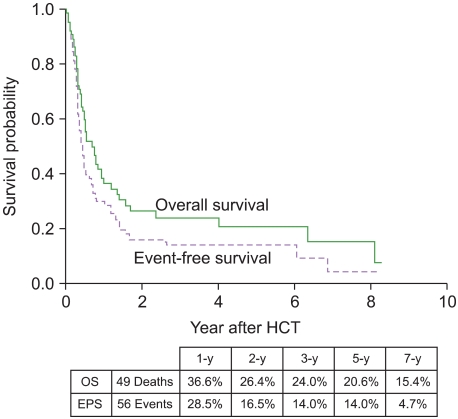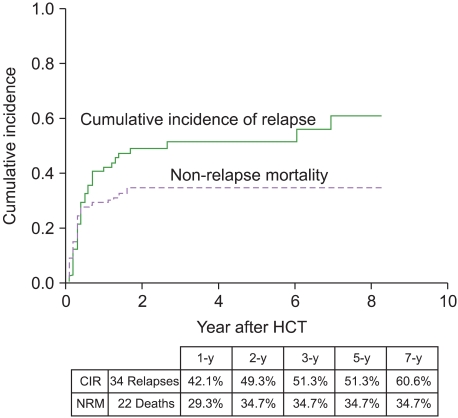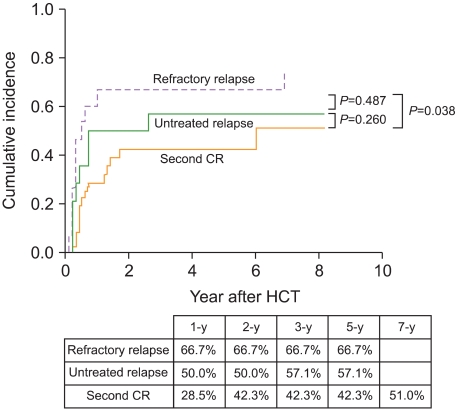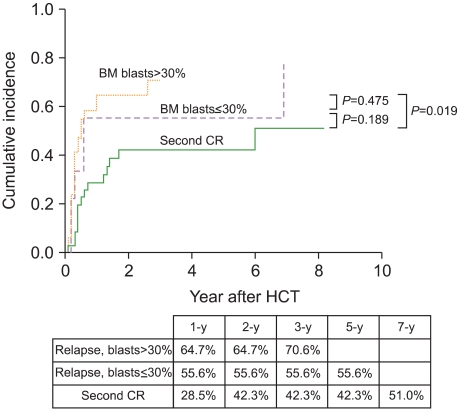Korean J Hematol.
2010 Jun;45(2):95-101. 10.5045/kjh.2010.45.2.95.
Allogeneic hematopoietic cell transplantation for acute leukemia in first relapse or second remission
- Affiliations
-
- 1Department of Internal Medicine, Asan Medical Center, University of Ulsan College of Medicine, Seoul, Korea.
- 2Department of Internal Medicine, Seoul National University Hospital, Seoul National University College of Medicine, Seoul, Korea. ssysmc@snu.ac.kr
- 3Department of Internal Medicine, Samsung Medical Center, Sungkyunkwan University School of Medicine, Seoul, Korea.
- 4Department of Preventive Medicine, University of Ulsan College of Medicine, Seoul, Korea.
- KMID: 2083541
- DOI: http://doi.org/10.5045/kjh.2010.45.2.95
Abstract
- BACKGROUND
The role of pre-transplant salvage chemotherapy has been controversial in relapsed acute leukemia.
METHODS
We investigated post-transplant outcomes in 65 patients with acute leukemia treated with allogeneic hematopoietic cell transplantation (HCT) during first relapse or second remission.
RESULTS
The 5-year cumulative incidence of relapse (CIR) was 52.3%. Multivariate analysis for CIR revealed that patients with unfavorable cytogenetics and those not in remission at the time of HCT had a significantly high CIR (P = 0.031 and P = 0.031, respectively). Allogeneic HCT was performed in 14 patients after first relapse without salvage chemotherapy ("untreated relapse" group), 15 patients failed chemotherapy for reinduction of remission before HCT ("refractory relapse" group), and 36 patients attained second remission with salvage chemotherapy before HCT ("second remission" group). The 5-year CIR for patients in the untreated relapse group (57.1%) was higher than that for those in the second remission group (42.3%), but it was lower than that for patients in the refractory relapse group (66.7%). Among patients who underwent allogeneic HCT in relapse, those with bone marrow (BM) blasts < or =30% had a lower 5-year CIR than those in florid relapse (BM blasts >30%) (57.7% vs. 70.6%).
CONCLUSION
Our results do not support the role of salvage chemotherapy aimed at re-induction of remission before allogeneic HCT in patients with acute leukemia after first relapse. Patients with early relapse do not appear to benefit from salvage chemotherapy before HCT.
MeSH Terms
Figure
Reference
-
1. Löwenberg B, Downing JR, Burnett A. Acute myeloid leukemia. N Engl J Med. 1999; 341:1051–1062. PMID: 10502596.
Article2. Rowe JM. What is the best induction regimen for acute myelogenous leukemia? Leukemia. 1998; 12(Suppl 1):S16–S19. PMID: 9777889.3. Estey EH. Treatment of relapsed and refractory acute myelogenous leukemia. Leukemia. 2000; 14:476–479. PMID: 10720145.
Article4. Ferrara F, Palmieri S, Mele G. Prognostic factors and therapeutic options for relapsed or refractory acute myeloid leukemia. Haematologica. 2004; 89:998–1008. PMID: 15339685.5. Lee JH, Choi SJ, Lee JH, et al. Continuous infusion intermediate-dose cytarabine, mitoxantrone, plus etoposide for refractory or early relapsed acute myelogenous leukemia. Leuk Res. 2006; 30:204–210. PMID: 16055185.
Article6. Leopold LH, Willemze R. The treatment of acute myeloid leukemia in first relapse: a comprehensive review of the literature. Leuk Lymphoma. 2002; 43:1715–1727. PMID: 12685823.
Article7. Stanisic S, Kalaycio M. Treatment of refractory and relapsed acute myelogenous leukemia. Expert Rev Anticancer Ther. 2002; 2:287–295. PMID: 12113052.
Article8. Brown RA, Wolff SN, Fay JW, et al. High-dose etoposide, cyclophosphamide, and total body irradiation with allogeneic bone marrow transplantation for patients with acute myeloid leukemia in untreated first relapse: a study by the North American Marrow Transplant Group. Blood. 1995; 85:1391–1395. PMID: 7858269.
Article9. Buckner CD, Clift RA, Thomas ED, et al. Allogeneic marrow transplantation for patients with acute non-lymphoblastic leukemia in second remission. Leuk Res. 1982; 6:395–399. PMID: 6750252.10. Clift RA, Buckner CD, Appelbaum FR, et al. Allogeneic marrow transplantation during untreated first relapse of acute myeloid leukemia. J Clin Oncol. 1992; 10:1723–1729. PMID: 1403055.
Article11. Doney K, Hägglund H, Leisenring W, Chauncey T, Appelbaum FR, Storb R. Predictive factors for outcome of allogeneic hematopoietic cell transplantation for adult acute lymphoblastic leukemia. Biol Blood Marrow Transplant. 2003; 9:472–481. PMID: 12869961.
Article12. Appelbaum FR, Clift RA, Buckner CD, et al. Allogeneic marrow transplantation for acute nonlymphoblastic leukemia after first relapse. Blood. 1983; 61:949–953. PMID: 6338977.
Article13. Nemecek ER, Gooley TA, Woolfrey AE, Carpenter PA, Matthews DC, Sanders JE. Outcome of allogeneic bone marrow transplantation for children with advanced acute myeloid leukemia. Bone Marrow Transplant. 2004; 34:799–806. PMID: 15361903.
Article14. Bortin MM, Gale RP, Kay HE, Rimm AA. Bone marrow transplantation for acute myelogenous leukemia. Factors associated with early mortality. JAMA. 1983; 249:1166–1175. PMID: 6337286.
Article15. Michallet M, Thomas X, Vernant JP, et al. Long-term outcome after allogeneic hematopoietic stem cell transplantation for advanced stage acute myeloblastic leukemia: a retrospective study of 379 patients reported to the Société Française de Greffe de Möelle (SFGM). Bone Marrow Transplant. 2000; 26:1157–1163. PMID: 11149725.16. Giralt S, Logan B, Rizzo D, et al. Reduced-intensity conditioning for unrelated donor progenitor cell transplantation: long-term follow-up of the first 285 reported to the national marrow donor program. Biol Blood Marrow Transplant. 2007; 13:844–852. PMID: 17580263.
Article17. Kaplan EL, Meier P. Nonparametric estimation from incomplete observations. J Am Stat Assoc. 1958; 53:457–481.
Article18. Peto R, Pike MC, Armitage P, et al. Design and analysis of randomized clinical trials requiring prolonged observation of each patient. II. analysis and examples. Br J Cancer. 1977; 35:1–39. PMID: 831755.
Article19. Prentice RL, Kalbfleisch JD, Peterson AV Jr, Flournoy N, Farewell VT, Breslow NE. The analysis of failure times in the presence of competing risks. Biometrics. 1978; 34:541–554. PMID: 373811.
Article20. Seal HL. Studies in the history of probability and statistics: XXXV. Multiple decrements or competing risks. Biometrika. 1977; 64:429–439.
Article21. Gray RJ. A class of K-sample tests for comparing the cumulative incidence of a completing risk. Ann Stat. 1988; 16:1141–1154.
Article22. Cox DR. Regression models and life tables. J R Stat Soc B. 1972; 34:187–202.23. Biggs JC, Horowitz MM, Gale RP, et al. Bone marrow transplants may cure patients with acute leukemia never achieving remission with chemotherapy. Blood. 1992; 80:1090–1093. PMID: 1498326.
Article24. Fung HC, Stein A, Slovak M, et al. A long-term follow-up report on allogeneic stem cell transplantation for patients with primary refractory acute myelogenous leukemia: impact of cytogenetic characteristics on transplantation outcome. Biol Blood Marrow Transplant. 2003; 9:766–771. PMID: 14677116.
Article25. Kataoka I, Kami M, Takahashi S, et al. The Japan Society for Hematopoietic Cell Transplantation Working Party. Clinical impact of graft-versus-host disease against leukemias not in remission at the time of allogeneic hematopoietic stem cell transplantation from related donors. Bone Marrow Transplant. 2004; 34:711–719. PMID: 15361916.26. Singhal S, Powles R, Henslee-Downey PJ, et al. Allogeneic transplantation from HLA-matched sibling or partially HLA-mismatched related donors for primary refractory acute leukemia. Bone Marrow Transplant. 2002; 29:291–295. PMID: 11896425.
Article27. Wong R, Shahjahan M, Wang X, et al. Prognostic factors for outcomes of patients with refractory or relapsed acute myelogenous leukemia or myelodysplastic syndromes undergoing allogeneic progenitor cell transplantation. Biol Blood Marrow Transplant. 2005; 11:108–114. PMID: 15682071.
Article28. Copelan EA, McGuire EA. The biology and treatment of acute lymphoblastic leukemia in adults. Blood. 1995; 85:1151–1168. PMID: 7858247.
Article29. Grimwade D, Walker H, Oliver F, et al. The Medical Research Council Adult and Children's Leukaemia Working Parties. The importance of diagnostic cytogenetics on outcome in AML: analysis of 1,612 patients entered into the MRC AML 10 trial. Blood. 1998; 92:2322–2333. PMID: 9746770.
Article30. Slovak ML, Kopecky KJ, Cassileth PA, et al. Karyotypic analysis predicts outcome of preremission and postremission therapy in adult acute myeloid leukemia: a Southwest Oncology Group/Eastern Cooperative Oncology Group Study. Blood. 2000; 96:4075–4083. PMID: 11110676.
Article31. Chalandon Y, Barnett MJ, Horsman DE, et al. Influence of cytogenetic abnormalities on outcome after allogeneic bone marrow transplantation for acute myeloid leukemia in first complete remission. Biol Blood Marrow Transplant. 2002; 8:435–443. PMID: 12234169.
Article32. Ferrant A, Labopin M, Frassoni F, et al. Acute Leukemia Working Party of the European Group for Blood and Marrow Transplantation (EBMT). Karyotype in acute myeloblastic leukemia: prognostic significance for bone marrow transplantation in first remission: a European Group for Blood and Marrow Transplantation study. Blood. 1997; 90:2931–2938. PMID: 9376573.33. Keating S, Suciu S, de Witte T, et al. The European Organization for Research and Treatment of Cancer (EORTC) and the Gruppo Italiano Malattie Ematologiche Maligne dell' Adulto (GIMEMA) Leukemia Cooperative Groups. Prognostic factors of patients with acute myeloid leukemia (AML) allografted in first complete remission: an analysis of the EORTC-GIMEMA AML 8A trial. Bone Marrow Transplant. 1996; 17:993–1001. PMID: 8807105.34. Long GD, Amylon MD, Stockerl-Goldstein KE, et al. Fractionated total-body irradiation, etoposide, and cyclophosphamide followed by allogeneic bone marrow transplantation for patients with high-risk or advanced-stage hematological malignancies. Biol Blood Marrow Transplant. 1997; 3:324–330. PMID: 9502300.35. Clift RA, Buckner CD, Appelbaum FR, et al. Allogeneic marrow transplantation in patients with acute myeloid leukemia in first remission: a randomized trial of two irradiation regimens. Blood. 1990; 76:1867–1871. PMID: 2224134.36. Appelbaum FR. Graft versus leukemia (GVL) in the therapy of acute lymphoblastic leukemia (ALL). Leukemia. 1997; 11(Suppl 4):S15–S17. PMID: 9179275.
- Full Text Links
- Actions
-
Cited
- CITED
-
- Close
- Share
- Similar articles
-
- A Case of Ovarian-Relapse Sparing of the Marrow in a Patient with Acute T Cell Lymphoblastic Leukemia after Allogeneic Hematopoietic Stem Cell Transplantation
- Long-Term Complete Remission in an Acute Myeloid Leukemia Patient with Isolated Central Nervous System Relapse after Allogeneic Hematopoietic Stem Cell Transplantation
- Unusual isolated extramedullary relapse of acute lymphoblastic leukemia in the breast despite complete donor hematopoietic chimerism after allogeneic hematopoietic stem cell transplantation
- Isolated Breast Relapse of Early T-Cell Precursor Acute Lymphoblastic Leukemia after Stem Cell Transplantation: A Pediatric Case and Literature Review
- A Case Report of the Second de Novo Acute Myeloid Leukemia (AML) Following Allogeneic Stem Cell Transplantation in a Patient with the First AML





